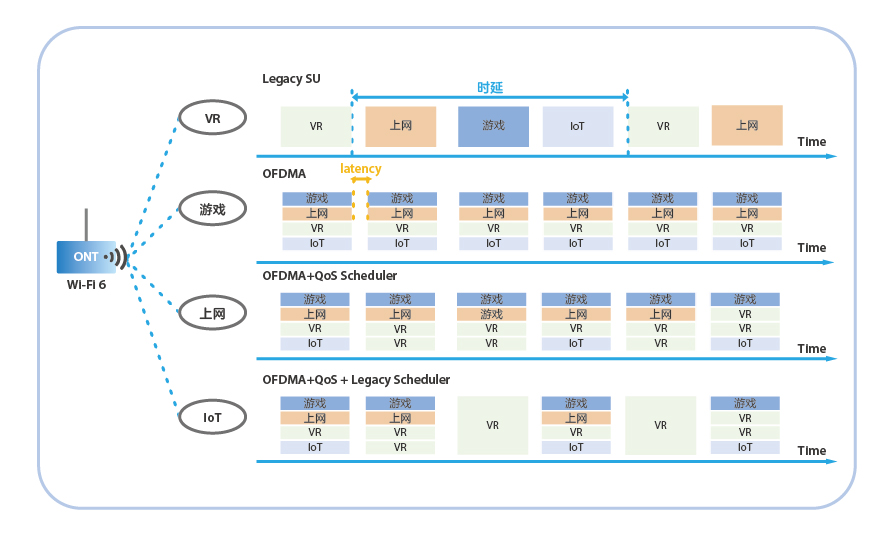Bai-link wireless coverage has been enhanced, and the home Wi-Fi experience has been upgraded
The essence of home services is to solve the needs of individuals in home scenarios, and the services that users use frequently at home are mainly mobile applications, so Wi-Fi capabilities within the home are particularly important. Through multi-AP networking, the problem of network presence and absence can be solved, which is the first step towards Wi-Fi for the whole house. However, users 'Wi-Fi experience still has insufficient specific service guarantees, slow switching around the house, and disconnection. and other issues. In order to help the family experience upgrade again, Wi-Fi coverage experience enhancement technology is needed.
Wi-Fi 6 intelligent QoS ensures low-latency service performance
Different services have different requirements for latency. Current home services can be divided into: bandwidth-sensitive services, such as 4K/8K video; delay-sensitive services, such as VR, games and telecommuting; stability-sensitive services, such as VR, smart home, etc. These three types of services mature and develop in stages, first meeting bandwidth-based service requirements, and then meeting low-latency and high-reliability service requirements. Based on the rapid popularization of Gigabit broadband and Gigabit Wi-Fi, home bandwidth will no longer be a bottleneck. Currently, games, VR, distance education and telecommuting have become services that are used very frequently by users, so QoS guarantees based on Wi-Fi are increasingly important to enhance new business experiences.
Wi-Fi 6 intelligent QoS technology optimizes the latency of delay-sensitive services and high-interest services, ensuring the ultimate experience for home users. Intelligent QoS uses two core technologies: Delay-Aware Bandwidth Schedule (DABS), single-user OFDM and multi-user OFDMA (OFDM+OFDMA) joint scheduler to optimize the setting of delay-sensitive services and high-interest services. Mechanism to expect QoS for delay.
DABS technology can optimize the queue priority of high-interest service packages, reduce the latency of high-value services and improve the effectiveness of communication. When traffic is sent to the home gateway, the characteristic values carried by the service perception identification are first analyzed, and the service is assigned to different priority queues based on the characteristic values. Define the priority from high to low as four queues: "VO","VI","BE" and "BK". Queue with high priority will be scheduled first. In addition to scheduling services by priority queues, different services in the same queue can be further distinguished and guaranteed through the DABS mechanism. A "service delay requirement table" will be established in the DABS mechanism, in which "delay binding values" are listed according to the service delay requirements of different services.
On the other hand, the OFDM+OFDMA joint scheduler can realize dynamic scheduling in the time and frequency domains. The mechanism of this technology reduces competition conflicts by allocating more spectrum resources and time slots, further reduces the delay of high-value services, and realizes support The effect of setting the desired QoS for the delay for specific high-value services (VR, live broadcast, games, etc.) improves the communication efficiency of the entire machine.
Figure 1 lists several scheduling methods for traffic traffic. In terms of cloud VR services, personal-side VR service access requires network bandwidth guarantees with large bandwidth and low latency. Operation-level 8K VR requires stable bandwidth of more than 130Mbps, and the end-to-end latency is less than 20 ms. The future ultimate VR experience requires a network with a delay of less than 8 ms. Assuming that VR service is set to the highest priority, its traffic will be sent to the "VO" queue, and different service packets will be reordered according to the delay binding value of DABS in the "VO" queue. Compared with single-user OFDM scheduling, multi-user OFDMA can effectively reduce the waiting time when transmitting adjacent data packets for the same service (such as VR service), thereby effectively reducing latency. After actual testing and comparison, after using Wi-Fi 6 intelligent QoS technology, the latency of cloud VR services is reduced from 40ms to 12ms, and the latency optimization reaches 70%.

Fig. 1 Illustration of different service scheduling methods
Mesh ZSR smart roaming mechanism solves the problem of full house coverage
Wi-Fi 6 AP can provide users with high bandwidth and ensure low-latency service performance. However, the AP at a single point will be limited to a certain coverage range, and the rate drop will be more obvious after long distances or multiple penetration. Solving the problem of multi-room coverage requires the use of multiple routers for networking coverage, but multi-AP networking will face problems such as roaming interruption, difficulty in installation, high interference, and robustness of the backhaul link. At this time, Mesh networking technology needs to be introduced, which is a key technology to solve the multi-AP networking problem. In order to ensure the roaming effect of different Mobile device indoors, another self-developed algorithm for ZTE's home smart terminals: Mesh ZSR Smart Roaming, ensures the best Wi-Fi connection through the three-step process of "decision, selection, and switching", solves the roaming outage problem often faced by multi-AP networking, and achieves a full-house intelligent experience.
- Stable state mechanism for accurate roaming decision-making: Roaming decision-making adopts a stable state mechanism. RSSI (signal strength) and PER (bit error rate) are tested multiple times to make roaming judgment. If the roaming conditions are stably met multiple times, the pre-roaming state will be entered; if the detection is in a critical state for roaming, roaming is not allowed under this condition to prevent ping-pong effect.
- Five-dimensional scoring system: After the device enters the pre-roaming state, it measures the five-dimensional indicators of RSSI, bandwidth, load, working frequency band, and routing hop count of surrounding connectable APs for evaluation to select the best target AP.
- Formulate the optimal handover mode based on terminal capabilities: During the rapid roaming handover process, formulate the optimal handover mode based on the ability to connect the terminal and optimize the forwarding path, thereby shortening the roaming time. Determine whether the terminal meets the 802.11k/v protocol through the STA (Wireless Terminal) analysis model. If it does not meet the 802.11k/v protocol is used to force switching paths; if it does, use the 802.11k/v communication protocol to reduce the 4 handshake and chain establishment process to 2, and the forwarding path is quickly and synchronously updated.
Mesh APs equipped with Mesh ZSR smart roaming algorithm perform outstanding key roaming performance among products of the same specification (see Table 1). Among products of the same specification, the packet loss and uninterrupted success rate are basically the same as those of other product indicators, while the delay and handover success rate indicators of Wi-Fi signals at 2.4GHz and 5GHz are better than those of the other three manufacturers, effectively optimizing the roaming experience.
table 1 Comparison of key indicators for performance test roaming of products with the same specifications

The Wi-Fi coverage experience enhancement solution relies on two mechanisms: Wi-Fi 6 intelligent QoS and Mesh ZSR intelligent roaming to ensure the upgrade of home business experience and solve the problem of QoS guarantee for specific services and seamless switching of Mobile device in the entire house network.












